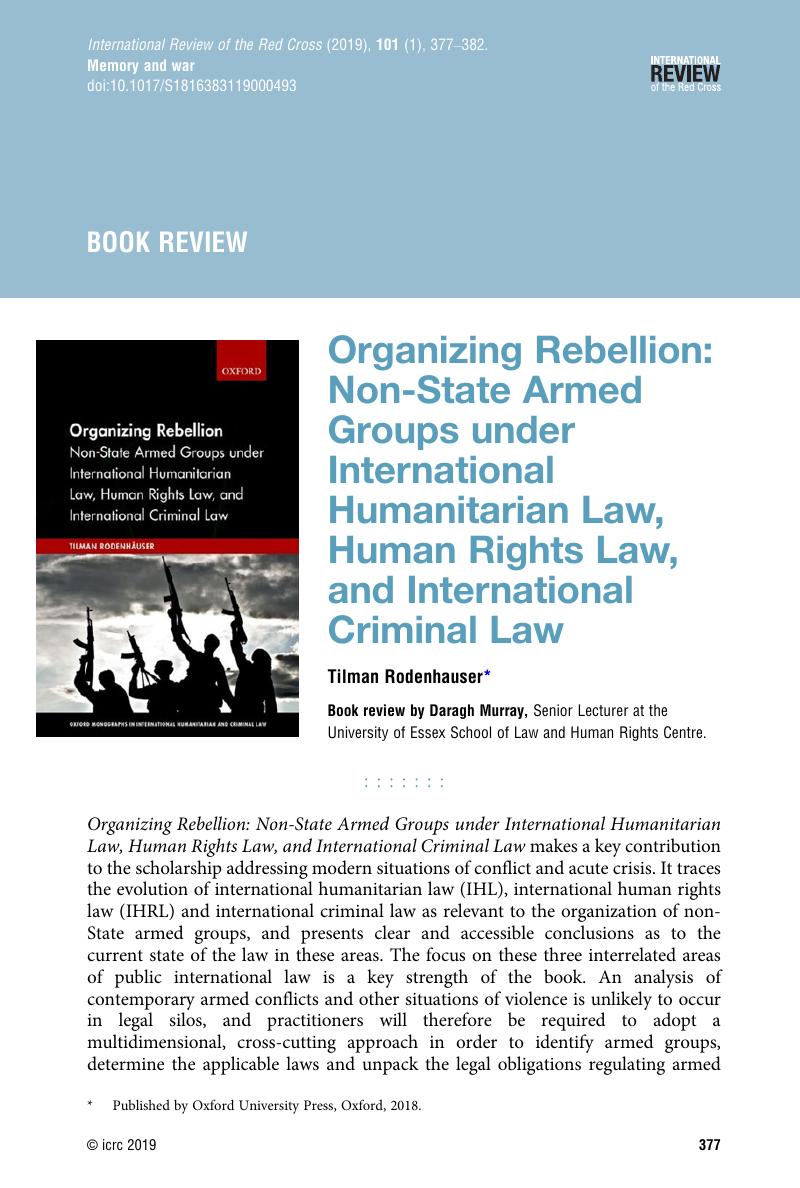No CrossRef data available.
Article contents
Organizing Rebellion: Non-State Armed Groups under International Humanitarian Law, Human Rights Law, and International Criminal Law Tilman Rodenhauser *
Published online by Cambridge University Press: 12 November 2019
Abstract

- Type
- Books and articles
- Information
- International Review of the Red Cross , Volume 101 , Issue 910: Memory and war , April 2019 , pp. 377 - 382
- Copyright
- Copyright © icrc 2019
Footnotes
Published by Oxford University Press, Oxford, 2018.
References
1 Examples in this regard include the Confederate forces during the American Civil War, the Boers fighting British forces in South Africa, and the nationalist forces under General Franco in the Spanish Civil War.
2 This is typically examined by reference to whether an armed group can be considered “organized” as defined in the body of international law under consideration.
3 Cullen, Anthony, The Concept of Non-International Armed Conflict in International Humanitarian Law, Cambridge University Press, Cambridge and New York, 2010CrossRefGoogle Scholar; Moir, Lindsay, The Law of Internal Armed Conflict, Cambridge University Press, New York, 2002CrossRefGoogle Scholar.
4 Lubell, Noam and Derejko, Nathan, “A Global Battlefield? Drones and the Geographical Scope of Armed Conflict”, Journal of International Criminal Justice, Vol. 11, No. 1, 2013CrossRefGoogle Scholar.
5 Sivakumaran, Sandesh, The Law of Non-International Armed Conflict, Oxford University Press, Oxford, 2012Google Scholar.
6 Murray, Daragh, Human Rights Obligations of Non-State Armed Groups, Hart, 2016Google Scholar; Fortin, Katharine, The Accountability of Armed Groups Under Human Rights Law, Oxford University Press, Oxford, 2017CrossRefGoogle Scholar.
7 Schmitt, Michael N. (ed.), Tallinn Manual 2.0 on the International Law Applicable to Cyber Operations, Cambridge University Press, Cambridge, 2017CrossRefGoogle Scholar.
8 Wilmshurst, Elizabeth (ed.), International Law and the Classification of Conflicts, Oxford University Press, Oxford, 2012CrossRefGoogle Scholar.
9 It may also be important to identify other actors: for instance, looser organizations not typically characterized as armed groups may be relevant in the context of crimes against humanity.
10 Organizing Rebellion, p. 84.
11 This would facilitate, for example, an analysis of whether Free Syrian Army units in Daraa and Homs – or Al Qaeda branches in Afghanistan, Iraq or the Islamic Maghreb – could be considered to form part of the same organization and thus be considered to be one party to an armed conflict.
12 This requires, for example, that in the event of a conflict, rules promulgated by the central organization will take precedence.
13 Organizing Rebellion, p. 303.
14 See, for instance, Sections 9.2 and 10.3.




